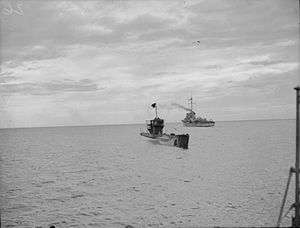HMS Byron (K508)
 HMS Byron, background, escorts surrendering German submarine U-1009 into Loch Eriboll, Scotland, May 1945 | |
| History | |
|---|---|
| Laid down: | 24 May 1943 |
| Launched: | 14 August 1943 |
| Commissioned: | 30 October 1943 |
| Decommissioned: | Returned to US Navy on 24 November 1945 |
| Fate: | Struck from the Navy list and sold for scrap on 25 October 1947 |
| General characteristics | |
| Displacement: | 1,800 tons fully loaded |
| Length: | 306 ft (93 m) overall |
| Beam: | 36.5 ft (11.1 m) |
| Draught: | 11 ft (3.4 m) fully loaded |
| Speed: | 24 knots (44 km/h) |
| Endurance: | 5,500 nautical miles (10,200 km) at 15 knots (28 km/h) |
| Complement: | Typically between 170 & 186 |
HMS Byron was a British Captain class frigate (US built as a Buckley class escort) of World War II. Named after Vice-Admiral The Honourable John Byron whose frequent encounters with bad weather in ensuing years won him the sobriquet, “Foul Weather Jack”.
Commanding Officers were Lt K C L Southcombe RN October 1943 and Lt J Burfield RN February 1945.
Actions
During World War II, HMS Byron earned battle honours for service in the English Channel, the Arctic, and the Atlantic in 1944 and in the North Sea in 1944 and 1945. In the course of these operations, she participated in the destruction of two German U-boats: U-722 on 27 March 1945 off the Hebrides, in position 57°09′N 06°55′W / 57.150°N 6.917°W, by depth charges in company with HMS Fitzroy and HMS Redmill; and, teaming with HMS Fitzroy, U-1001 on 8 April 1945 south-west of Land's End, in position 49°19′N 10°23′W / 49.317°N 10.383°W, by depth charges.
General information
- Pennant (UK): K 508
- Hull number (US): DE 79
- Built by: Bethlehem-Hingham Shipyard Inc. (Hingham, Massachusetts, U.S.A.)
Notes
External links
- Uboat.net page for HMS Byron
- Uboat.net page for U-722
- Uboat.net page for U-1001
- captainclassfrigates.co.uk
References
- The Captain Class Frigates in the Second World War by Donald Collingwood. published by Leo Cooper (1998), ISBN 0-85052-615-9.
- The Buckley-Class Destroyer Escorts by Bruce Hampton Franklin, published by Chatham Publishing (1999), ISBN 1-86176-118-X.
- German U-Boat Losses During World War II by Axel Niestle, published by United States Naval Inst (1998), ISBN 1-55750-641-8.
This article incorporates text from the public domain Dictionary of American Naval Fighting Ships. The entry can be found here.